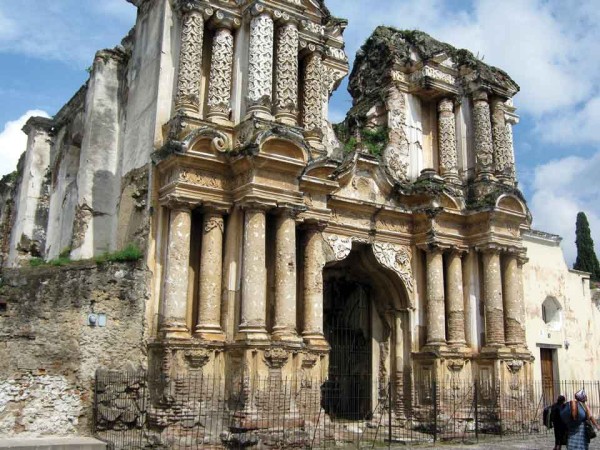Lured to La Antigua

In 1946 Gore Vidal purchased the property adjacent to the elaborate façade of the Church of El Carmen. (photo by Jack Houston)
Mystery tantalizes the memory of Amelia Earhart, who disappeared somewhere over the Pacific during her attempted flight around the globe in 1937, piloting her twin-engine plane with only a navigator aboard. The world watched and waited as communication broke, came again, broke again and eventually fell silent. In the early days of aviation, Earhart’s gutsy solo flight across the Atlantic in 1932 and support of women aviators and other feminist causes won her popularity.
That popularity and tantalizing memory would find its way into a colonial church ruin in La Antigua Guatemala.
Amelia Earhart’s public was devastated that July night in 1937, but none so much as the boy who called himself Gore. Born Eugene Luther Gore Vidal at the United States West Point Military Academy Hospital in 1925, he chose to be called Gore after his maternal grandfather, Thomas Gore, democratic senator from Oklahoma. Growing up in Washington D.C., young Gore often read aloud to his grandpa, who was blind, while absorbing political philosophies.
Amelia Earhart also became very special to the boy. Gore’s father, according to biographer Susan Butler, was the great love of her life. They never married, but the pair worked together to further passenger air travel, while their romance sizzled. During that time, the boy Gore became fond of Amelia and found in her a substitute mother. Gore’s mother, an actress and socialite, had divorced his dad in 1935 to marry wealthy stockbroker Hugh Auchincloss, later stepfather of Jackie Kennedy.
Gore grew up and, after serving in World War II, began to write novels. In 1946 he moved to Guatemala and bought a piece of property adjacent to the ruins of the Church of El Carmen, including what was the sacristy. Little is known of the church’s history, but a simple hermitage built to shelter an image of the Virgin Mary was destroyed by earthquake in 1717 and replaced with an elaborate baroque structure, the facade of which remains one of the most photographed in La Antigua Guatemala. Royal edict declared that the convent for the Capuchin nuns would be established there. But the place was deemed unsuitable when the nuns arrived in 1726, and a new site was purchased.
Vidal hired architect and artist Pat Crocker to make the place livable. Crocker’s paintings are well-known in Antigua, and he also edited one of Vidal’s novels. Among Gore Vidal’s orders was a fireplace ‘with no flat surfaces’, so the typical straight line Antigua style was scratched for a flamboyant curvilinear design. A later owner, who bought the house from Vidal, told this writer that Gore wanted to be sure there was no mantle for a photo of his mother.
Gore Vidal lived and wrote in his Antigua house from 1947 to 1949. He then turned to the more lucrative writing for screen, stage and then booming TV. He flirted with politics, returned to novels and became an outspoken and controversial essayist, historian, analyst and activist. His family provided a wealth of political and social connections to feed his prolific writing. After spending years in his Italian villa, he lives today in the United States.
Meanwhile, scientists examine findings on a remote island in the Pacific. Could Amelia Earhart have landed and lived out her life there?
Gore Vidal, who brought along his own intimate and affectionate memory of Amelia Earhart, represents the stream of writers and artists, archeologists and anthropologists, historians, adventurers, diplomats, freethinkers and just plain nice folk who have been lured by Antigua.